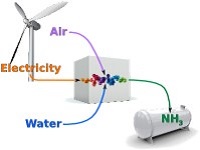Energy-Efficient and Economical Ammonia Production

Technology Description:
The team led by Starfire Energy will develop a modular, small-scale, HB-type process for ammonia synthesis. The team’s innovative approach is less energy-intensive and more economical than conventional, large-scale HB because a novel electroactive catalyst allows operation at lower temperatures and pressures. Their approach combines a high-activity precious metal catalyst and an electroactive catalyst support to form ammonia molecules, while operating at moderate pressures and using localized high-temperature reaction zones. The extreme reaction conditions in conventional HB require that the process runs continuously, as turning on and off would require bringing the reactor back up to synthesis temperature. Since Starfire’s process is smaller scale, it does not require continuous energy input and therefore could be compatible with intermittent energy sources, setting it on a path to be carbon-neutral.
Potential Impact:
If successful, the proposed technology could enable distributed ammonia production for alternative fuels and agricultural use, decrease energy input by more than 20%, and substantially simplify the process.
Security:
Around half of U.S. ammonia is currently imported. The proposed method enables domestic and distributed ammonia production to limit supply vulnerabilities.
Environment:
The team’s innovations could enable small-sale ammonia reactors that operate using intermittent renewable energy sources, thus making a zero-carbon fuel and fertilizer thereby reducing our carbon footprint.
Economy:
Low-cost production of ammonia could benefit stationary and transportation energy sectors as a lower cost alternative to batteries for long-term energy storage.
Contact
ARPA-E Program Director:
Dr. Grigorii Soloveichik
Project Contact:
Dr. Joseph Beach
Press and General Inquiries Email:
ARPA-E-Comms@hq.doe.gov
Project Contact Email:
Joe.Beach@StarfireEnergy.com
Partners
Colorado School of Mines
Related Projects
Release Date:
01/07/2015
